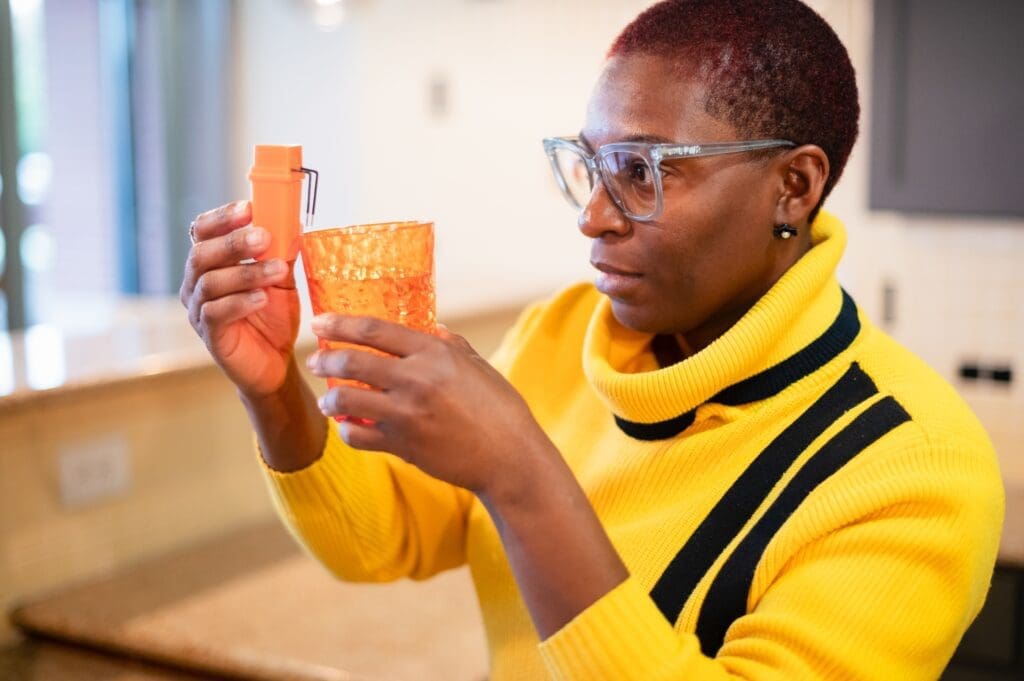One of the most important, but under-utilized, services available for people with vision loss from macular degeneration is Low Vision Rehabilitation.
Many people think they need to accept their vision loss and the subsequent losses of favorite activities and independence, leading to lower quality of life, grief, and depression1. This does not have to be true. With the right training and tools, individuals can continue to enjoy activities and a good quality of life.
Patients report improvements in quality of life after receiving low-vision services2.
What is Low Vision Rehabilitation?
Low vision rehabilitation assesses your remaining vision, and then maximizes the use of your remaining vision through a combination of vision retraining, skills training, environmental modifications, and assistive devices and technology.
A typical low vision rehabilitation service can include:
- Vision assessment – this is to determine the level and nature of your vision loss.
- Interview – to determine your typical daily activities, and how your vision loss is impacting them.
- Corrective lens prescriptions – for glasses or contact lenses.
- Device recommendations and training – these can include optical and electronic magnification devices, and other assistive technology.
- Environmental modifications – some services will send a provider to your home to assess your living space for potential modifications that can improve safety, mobility, and independence.
The aim is to help maximize your vision with a personalized plan that utilizes a blend of training, devices, and technology that control glare, enhance contrast, improve eccentric viewing, and enhance visual field3. As a result, remaining vision is enhanced and supplemented.

Who Offers Low Vision Rehabilitation?
Doctor of Optometry
Some Doctors of Optometry, or Optometrists, specialize in low vision rehabilitation. They can offer a visual acuity assessment, prescribe corrective lenses, and recommend and sell low vision devices such as optical and magnification devices. They can also refer you to additional services, such as a certified vision rehabilitation therapist, a social worker or therapist, and support groups.
Certified Vision Rehabilitation Therapist
Vision rehabilitation therapists don’t prescribe corrective lenses. Instead, they focus on training people with visual impairment compensatory skills and the use of assistive technology to enhance independence and quality of life. Training and tools are personalized to each patient based on the type and amount of vision loss, as well as each person’s needs and goals.
Additional Professionals
In addition to the above, other professionals may play a part in low vision rehabilitation. These can include: occupational therapists, teachers of the visually impaired, assistive technology specialists, orientation and mobility specialists, activities of daily living instructors, and vocational rehabilitation counselors. You may also find therapy or support groups to be helpful in the emotional adjustment to vision loss, and this can help bolster success with low vision rehabilitation.
Finding Low Vision Rehabilitation Services
You may be fortunate to find a comprehensive low vision center near you that offers several types of services and professionals under one roof that can help with visual assessment, training, assistive tech selection and training, home and work modifications, emotional support, mobility training, and more.
These types of centers can be private, or non-profits. Depending on where you live, there may be more than one option available to you. At minimum, every state have agencies for the blind/visually impaired that offer services. Eligibility varies by state, and you may need a formal assessment and referral from your eye specialist.
The best place to start, is to ask your eye care specialist if they know of any low vision centers near you, and if they think you would qualify for those services. If your eye care specialist doesn’t know, or doesn’t seem informed, you can still do your own searching online. Use Google maps or Google to search for terms like, “low vision center”, “low vision services”, “low vision rehabilitation”, “commission for the blind”, “agency for the blind”, and “services for the blind”. Also search to see if there is a Lighthouse Guild near you. This should root out all the available services in your area, and you can make a list to call around for more information.
If you are a veteran, you may be eligible for low vision services through your local VA.
If you are still employed, you may be eligible for low vision services through your state’s vocational rehabilitation agency.
Does Insurance Cover Low Vision Rehabilitation?
Some insurance plans will cover some low vision services if you qualify. But as of this writing, insurance, including Medicare coverage, does NOT cover the cost of low vision devices or assistive technology, including, shockingly, the white cane. AMDF, along with many aligned organizations, are working to change this. You can help! Join our advocate mailing list at the bottom of this page, and we’ll be in touch when action is needed.
Further Resources
Searching for low vision services (in place of or in addition to Google Maps)
- VisionAware’s Directory of Services (organized by category)
- Rehabilitation Services Administration’s State Vocational Rehabilitation Agency Directory
- American Optometric Association’s Eye Doctor Directory — select ‘low vision’ or ‘vision rehabilitation’
- American Academy of Ophthalmology’s Ophthalmologist Directory — filter by the “vision rehab” subspecialty
For tips on daily living with vision loss:
- The American Macular Degeneration Foundation’s Videos on AMD Living
- American Academy of Ophthalmology’s Resources for People with Low Vision
- American Optometric Association’s Vision Rehabilitation Resources
- Lighthouse Guild’s Tele-Support Groups
______________________________
References
- Tran, E., Shah, N., Xu, R., Aly, M., & Malvankar-Mehta, M. S. (2023). Effects of low-vision rehabilitation on reading speed and depression in age-related macular degeneration: A systematic review and meta-analysis. British Journal of Visual Impairment, 0(0). https://doi.org/10.1177/02646196231217414 ↩︎
- Stelmack, Joan OD, FAAO. “Quality of Life of Low-Vision Patients and Outcomes of Low-Vision Rehabilitation” Journal of the American Academy of Optometry, Optometry and Vision Science, vol. 78(5), 2001, p 335-34. ↩︎
- Low Vision and Vision Rehabilitation. (n.d.). American Optometric Association. Retrieved June 13, 2024, from https://www.aoa.org/healthy-eyes/caring-for-your-eyes/low-vision-and-vision-rehab?sso=y ↩︎


